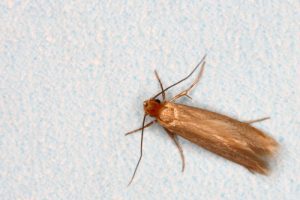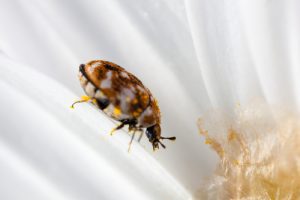Wool Rug Has Holes
By Chris Williams on March 22, 2012.
Q. What can eat a wool rug. We were moving some furniture around in our living room to make space for a new couch. When we moved the large hutch from where it had been for 20 years, the oriental rug underneath it was almost gone. The rest of the rug had no signs of damage, and we have not noticed any bugs in that room. What may have done this to our rug.
A. It sounds like one of two likely pests have been working on your rug. Clothes moths and carpet beetles are able to eat material containing keratin. Real wool rugs, wool tapestries, wool clothing, hides, trophy mounts, and fur coats all contain sufficient keratin and are attractive food sources. Human hair, feathers, and pet fur also contain keratin. Synthetic fibers are not food sources for clothes moths or carpet beetles.
 There are two species of clothes moths. The Webbing clothes moth (Tineola bisselliella) is the most common species found in the Northeast, although found throughout the country. Casemaking clothes moths (Tinea pellionella) are more common in southern states but are also widespread. Webbing clothes moth larvae spin small strands of silk into tubes or mats and may move about “naked” for several days before producing any webbing. This material accumulates as the population builds up. Casemaking clothes moths larvae spin little cases that they reside in and the head pops out to feed. Damage usually takes place in dark, hidden areas, like under furniture or inside closets and dressers that are rarely opened.
There are two species of clothes moths. The Webbing clothes moth (Tineola bisselliella) is the most common species found in the Northeast, although found throughout the country. Casemaking clothes moths (Tinea pellionella) are more common in southern states but are also widespread. Webbing clothes moth larvae spin small strands of silk into tubes or mats and may move about “naked” for several days before producing any webbing. This material accumulates as the population builds up. Casemaking clothes moths larvae spin little cases that they reside in and the head pops out to feed. Damage usually takes place in dark, hidden areas, like under furniture or inside closets and dressers that are rarely opened.
Control of clothes moths (these recommendations will be effective for both species) starts with thorough cleaning. Vacuuming corners, cracks, crevices, and under furniture will remove accumulations of lint, animal fur, hair, dead skin, and other clothes moth food materials. Cleaning out closets, removing animal and insect nests, animal carcasses, utilizing sealed storage containers, dry cleaning, rug cleaning, steam cleaning, beating, and exposure to sun light, will all reduce clothes moth activity. Rotating the position of rugs will kill the fragile larvae by exposing them to sunlight (a natural killer of clothes moth larvae) and foot traffic. Stored wool clothing and blankets should be inspected an laundered periodically. Upholstered furniture, animal specimens, furs, feathers, and mounted trophies should be inspected for signs of infestation. Storage of materials susceptible to clothes moth damage is critical. Sealed containers, tied or Ziploc plastic storage bags, and sealed trunks will prevent infestation. Moth balls may be of some use. Dry cleaning kills all stages of clothes moth as well as professional rug cleaning. Some establishments offer rug cleaning and storage.
 Carpet beetles belong to the Dermestid family. This broad grouping of beetles is responsible for large amounts of damage due to the wide range of materials that they are able to consume for food. Dermestid beetles are used by museums and collectors of bones as a means to clean skeletons. Common members of the family Dermestidae include the furniture carpet beetle, the common carpet beetle, the varied carpet beetle, the black carpet beetle, the larder beetle, the hide beetle, and the warehouse beetle. Some carpet beetle adults are attracted to pollen and nectar from flowers and may enter a home on cut flowers. Once established inside, carpet beetles may continue to reproduce using food sources within the house.
Carpet beetles belong to the Dermestid family. This broad grouping of beetles is responsible for large amounts of damage due to the wide range of materials that they are able to consume for food. Dermestid beetles are used by museums and collectors of bones as a means to clean skeletons. Common members of the family Dermestidae include the furniture carpet beetle, the common carpet beetle, the varied carpet beetle, the black carpet beetle, the larder beetle, the hide beetle, and the warehouse beetle. Some carpet beetle adults are attracted to pollen and nectar from flowers and may enter a home on cut flowers. Once established inside, carpet beetles may continue to reproduce using food sources within the house.
Adult carpet beetles are small oval to slightly elongated, and have a checkered pattern of scales on the top, or dorsal side. The black carpet beetle is all black and more elongated. Carpet beetle larvae are dark with hairy yellow stripes. The hairs are arranged in tight patterns and stripes and may be ¼ inch long. These slow moving worm like larvae cast their skins when they molt. Both the hairs and cast skins may accumulate at the food source. Large infestations may present thousands of cast larval skins. Cast skins and adults walking on windows may be the first sign of carpet beetle infestation.
Carpet beetles have a complex life cycle and undergo a complete metamorphosis (adult-egg-larvae-pupae-adult). Adult carpet beetles live between 20 and 60 days. Females lay up to 100 eggs on the larval food source, which hatch in 8-25 days depending on climatic conditions. The larval period may be as long as 1 year(larvae do most of the damage), and pupation may take almost a month.
Carpet beetles chew holes in carpets and fabrics. Damage is usually concentrated in one area, unlike moth damage which occurs as scattered holes. Adults, larvae, and cast larval skins are found in the damaged area. Carpet beetles are also the source of allergies among sensitive individuals. Hairs from the larval skins can be quite irritating and may cause dermatitis, nasal and sinus irritation. Dermestids feeding on hides and carcasses have also been implicated in the spread of anthrax bacilli.
If a carpet beetle infestation is suspected, a careful search for the food source is required. Check carpets, stuffed furniture, stored fabrics, areas with accumulations of pet fur, hides, furs, tapestries, animal nests, garbage and debris piles, cut flowers or blooming flowers and bushes near unscreened windows.
Control of carpet beetles involves several factors. Storage of fabric, woolens, and other potential food sources in sealed containers will prevent oviposition, or egg laying. Avoidance of fabrics, and furnishings of animal origin will prevent carpet beetle infestations, or limit their severity. Tight fitting screens and doors will also prevent invader carpet beetles from ending up inside. Animal and insect nests may also harbor carpet beetles and should be removed appropriately. Sealing cracks to prevent the build of human and animal hair will also limit the breeding sites that are available to carpet beetles. A strong vacuum or carpet cleaner will do a great job on carpets and rugs, be sure to clean both sides. Steam cleaning, rug rotation, and washing in soapy water will also help control carpet beetles. If these measures are not sufficient to control the infestation you are dealing with, the treatment for carpet beetles and clothes moths is almost identical and very effective. Pest Control Professionals are licensed to make safe and effective treatments to control clothes moths and carpet beetles.